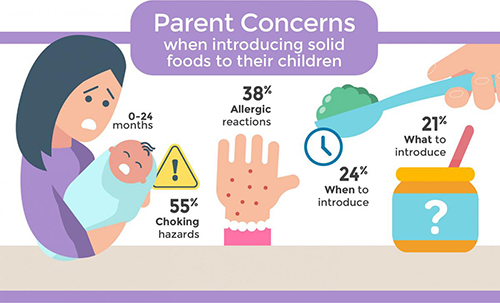(WASHINGTON, D.C.) — Parents of children under 24 months old are quite confident that they are feeding them an age-appropriate and nutritious diet—admitting, in fact, that their children’s diets are more nutritious than their own. But a new survey by the International Food Information Council (IFIC) Foundation also reveals parents’ underlying concerns around issues like what foods to introduce into their kids’ diets and when.
The survey of 1,001 parents with children from birth to 24 months (“B to 24”) found that 53 percent are very confident that they are feeding their child an age-appropriate, nutritious diet, while another 44 percent are at least somewhat confident.
Despite that confidence, however, some parents expressed concerns and confusion about what they feed B-to-24 children. For instance, as parents introduce children to solid foods, 55 percent of them say that choking hazards are a major concern, with 38 percent concerned about the potential for allergic reactions. In addition, 21 percent said a major concern was what foods to introduce, and 24 percent said when to introduce them. For those with children less than six months old, the number was even higher (33 percent).
Parents also are less than fully satisfied with the amount of information and guidance available about healthy eating and nutrition for children under 24 months. Only 42 percent are very satisfied. Pediatricians overwhelmingly are the primary source of information, cited by 77 percent of parents as a top source, followed by advice from their mother or mother-in-law (32 percent) and other family members (30 percent). Also striking is the number of children whose child care provider has at least some impact on a child’s diet (79 percent).
“What we feed our children as infants and babies can make a big difference in their health and dietary habits as they grow older,” said Alexandra Lewin-Zwerdling, Vice President of Research and Partnerships at the IFIC Foundation. “The good news is that nearly 90 percent are following their primary source’s advice at least most of the time, and the vast majority of the time it’s a pediatrician. The significant impact of a child care provider on a child’s diet also speaks to the need to ensure nutrition messages are communicated to everyone providing care.”
The top reasons cited for not following advice include not agreeing with it (53 percent) and that a child’s eating habits or behavior makes it difficult (47 percent).

For the youngest set eating baby food and solids, half (51 percent) of parents say giving them an appropriate amount of vegetables is a top goal, followed by an appropriate amount of protein (41 percent), exposing them to new foods (38 percent), an appropriate amount of fruits (34 percent) and foods they enjoy (33 percent). And when it comes to factors that impact purchasing habits, nutrition is by far the top driver (62 percent say “very important”) followed by exposing a child to a variety of food tastes and flavors (42 percent). Knowing that their child enjoys eating the food was cited by 39 percent.
One area of concern and confusion was the milestones and transitions from one food to another. Overall, 68 percent of parents introduce baby foods at about six months or older, 90 percent introduce solids between six and 12 months, and 79 percent tend to start cow’s milk at about 12 months.
But there are gaps between when parents expected to introduce certain foods, and when they actually did so. For instance, 20 percent expected to introduce baby foods at 12 months or older, while only 10 percent did (the majority having done so long before); 17 percent expected to introduce cheese at 18 months, while only 6 percent did; and 24 percent expected to introduce yogurt at 18 months or older, while only 5 percent did. There were similar gaps for other foods.
Parents also closely weigh advantages and disadvantages of what they feed their children. For instance, the foods perceived as most nutritious, chosen among a list, were pureed green beans (25 percent), milk (22 percent) and yogurt (18 percent). Cheese led the list of foods considered least healthy, chosen by 34 percent.
Yet parents saw advantages even in foods that many perceived as less healthy. “Taste” or “because a child enjoys it” was seen as an advantage by 74 percent when it came to cheese. In some other foods, taste and enjoyment were also cited as greater advantages than some of the top-cited nutrition concerns.
“Consistent with what we have seen over many surveys about the foods adults consume, taste remains a top factor over our food choices,” Lewin-Zwerdling said. “Fortunately, our other findings bear out that nutrition is also quite important when it comes to what we feed our youngest children.
The findings were derived from an online survey of 1,001 parents of children ages birth to 24 months and was fielded June 4 to June 15, 2018. It was conducted by Greenwald & Associates, using ResearchNow’s consumer panel. Data were weighted by age, gender and education to accurately reflect the survey population. The survey was funded by the National Yogurt Association.